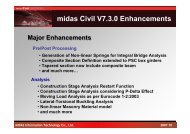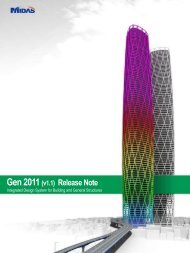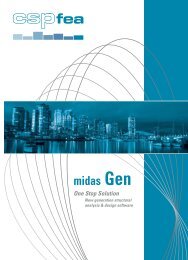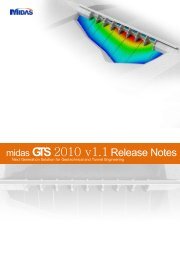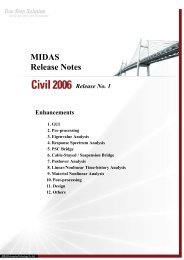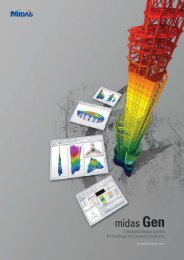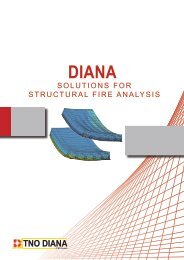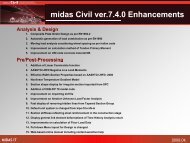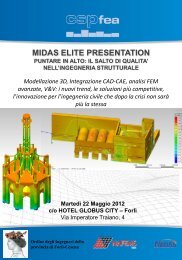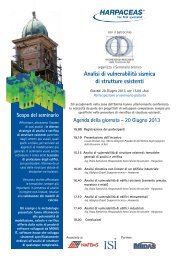midas Civil 2006 (V7.6.1) Enhancements - CSP Fea
midas Civil 2006 (V7.6.1) Enhancements - CSP Fea
midas Civil 2006 (V7.6.1) Enhancements - CSP Fea
- No tags were found...
You also want an ePaper? Increase the reach of your titles
YUMPU automatically turns print PDFs into web optimized ePapers that Google loves.
<strong>midas</strong> <strong>Civil</strong> <strong>2006</strong> (<strong>V7.6.1</strong>) <strong>Enhancements</strong>Analysis• Automatic Check for Tendon Stress Limits• Addition of Cable Efficiency Table• Addition of Time Dependent Material (Creep/Shrinkage, Compressive Strength and Tendon Loss) asper Eurocode2:04• Addition of the Time Dependent Material (Compressive Strength) as per CEB-FIP (1978)• Update on Time Dependent Material (Creep/Shrinkage, Compressive Strength and Tendon Loss) asper IRC:18-2000• Improvements of the Moving Load Analysis as per IRC: 6-2000• Addition of distributed springs• Addition of Sturm Sequence Check and Load Factor Range option in Buckling analysis• Improvements on the Eigenvalue analysis considering the maximum number of frequencies• Transfer reactions of slave nodes to the master node• Considering buckling load in the Pushover Yield Surface• Option for ignoring Lateral-Torsional Buckling mode in Buckling Analysis• Finding Concurrent Forces in Moving Load Analysis as per BS5400• Nonlinear Point Spring Supports for Construction Stage AnalysisApril, 2009
<strong>midas</strong> <strong>Civil</strong> <strong>2006</strong> (<strong>V7.6.1</strong>) <strong>Enhancements</strong>Pre/Post-Processing• Importing Composite Sections generated from SPC• Improvements on the display of Supports and Point Spring Supports• Addition of the Preference in online help• Addition of upside-down T-shape beam• Improvements in IS84 section DB• Save an image in JPG format• Addition of an export option in result tables• Export frame model to solid/plate model• Improvements in Beam WizardApril, 2009
MIDAS <strong>Civil</strong>Integrated Solution SystemFor Bridge and <strong>Civil</strong> Structure2009 UpgradeAutomatic Check for Tendon Stress LimitsUpgrade Contents• The program checks stresses in tendons based on the stress limits specified by the user.• In the Tendon Stress Limit Check table, the stresses in tendons, and the stress limits at the anchorages and elsewhere along the length of themember are displayed. If the stress in a tendon exceeds the stress limit, the corresponding row is marked in red.• When numerous tendons exist in a model file, this function is very convenient in checking the stress limits in a spreadsheet table format.Results > Result Tables > Tendon > Tendon Stress Limit CheckEffects & Usage[Tendon Stress Limit Check Table]3/26
MIDAS <strong>Civil</strong>Integrated Solution SystemFor Bridge and <strong>Civil</strong> Structure2009 UpgradeAddition of Cable Efficiency TableUpgrade Contents• Efficiency of inclined cables is computed in the Cable Efficiency Table.Results> Result Tables > Cable EfficiencyEffects & UsageCable efficiency, r, is calculated from the following equation:( EA) r( E A )modc1r 1 G cos E A /12Hc2 5 3c cwhere, G = the total weight of the cableL = the length of the chordH = the horizontal component of the cable tension, TE c = the modulus of elasticityA c = cross-sectional area of the cableα = the angle of the cableOnly cable elements can be checked in Cable Efficiency table.[Cable Efficiency Table]4/26
MIDAS <strong>Civil</strong>Integrated Solution SystemFor Bridge and <strong>Civil</strong> Structure2009 UpgradeAddition of Time Dependent Material (Creep/Shrinkage, Compressive Strength and Tendon Loss) as per Eurocode2:04• Time Dependent Material (Creep/Shrinkage, Compressive Strength and Tendon Loss) as per Eurocode2:04 is newly implemented.Upgrade ContentsModel > Properties > Time Dependent Material(Creep/Shrinkage)Model > Properties > Time Dependent Material(Comp. Strength)Load > Prestress loads > Tendon Property Compressive Strength Creep/Shrinkage Tendon Loss5/26
MIDAS <strong>Civil</strong>Integrated Solution SystemFor Bridge and <strong>Civil</strong> Structure2009 UpgradeAddition of the Time Dependent Material (Compressive Strength) as per CEB-FIP (1978)Upgrade Contents• Time Dependent Material (Compressive Strength) as per CEB-FIP(1978) is newly implemented.Model > Properties > Time Dependent Material (Comp. Strength)Note. Time Dependent Materials based on CEB-FIPare supported by <strong>midas</strong> <strong>Civil</strong> as shown in the tablebelow.Items CEB-FIP (1978) CEB-FIP (1990)Creep Available AvailableShrinkage Available AvailableComp.StrengthAvailableAvailable6/26
MIDAS <strong>Civil</strong>Integrated Solution SystemFor Bridge and <strong>Civil</strong> Structure2009 UpgradeUpdate on Time Dependent Material (Creep/Shrinkage, Compressive Strength and Tendon Loss) as per IRC:18-2000Upgrade Contents• Time Dependent Material (Creep/Shrinkage, Compressive Strength and Tendon Loss) as per IRC18:2000 is newly implemented.• Creep function can be shown as “creep strain per 10MPa” as well as “Creep Coefficient”.Model > Properties > Time Dependent Material(Creep/Shrinkage)Model > Properties > Time Dependent Material(Comp. Strength)Load > Prestress loads > Tendon Property Compressive Strength Creep/Shrinkage Tendon Loss7/26
MIDAS <strong>Civil</strong>Integrated Solution SystemFor Bridge and <strong>Civil</strong> Structure2009 UpgradeImprovements of the Moving Load Analysis as per IRC: 6-2000• User-defined Live Load Combinations, using both standard vehicle loads and user-defined vehicle loads, are newly implemented.• User-defined Impact Factors for Traffic Line Lanes are newly implemented.• The auto-calculated Impact Factors or user-defined Impact Factors can be checked in the *.OUT file.Upgrade ContentsEffects & Usage• The user can perform Moving Load Analysis by user-defined Live Load Combinations. The user can define a specific live load combination, andcheck the member forces obtained from the combination quickly and easily. This feature significantly reduces work-time when performing MovingLoad Analysis. (Please refer to overleaf example.)Load > Moving Load Analysis Data> Traffic Line Lane, Moving Load CasesTools > Text Editor[User-defined Impact Factor][User-defined Live Load Combinations][Output of Impact Factors in the *.OUT file]8/26
MIDAS <strong>Civil</strong>Integrated Solution SystemFor Bridge and <strong>Civil</strong> Structure2009 UpgradeExample: Improvements of the Moving Load Analysis as per IRC: 6-2000ProcedureThis example introduces how to define a specificLive Load Combination as shown in the figure 1.The user can consider this specific case bydefining Moving Load Case as described below.12[Figure 1. Example of vehicle loads]1After defining 5 Traffic Line Lanes and 2 vehicles(Class 70R and Class A), Click Load> MovingLoad Analysis Data> Moving Load Cases.361023Click Add.Enter the Load Case Name and Description.44Unselect Auto Live Load Combination* option.7115Click Add6Select the Class 70R vehicle and select theMin./Max. Number of Loaded Lanes as 278Select the Lane 2 & 3 and clickClick OK.8129Click Add.10Select the Class A vehicle and select the Min./Max.Number of Loaded Lanes as 111Select the Lane 5 and click12Click OK.5*Note. Auto Live Load CombinationSelect this option to define the Live LoadCombinations according to the clause 207.4. ofIRC: 6-2000. Unselect this option for userdefinedLive Load Combination.9[Figure 2. Moving Load Tracer]9/26
MIDAS <strong>Civil</strong>Integrated Solution SystemFor Bridge and <strong>Civil</strong> Structure2009 UpgradeAddition of distributed springsUpgrade Contents• Distributed springs on the beam, plate and solid elements.• Generate surface springs to represent the stiffness of the soil.• Consider accurate boundary conditions when modeling members on elastic subgrade.• Compression-only spring can be considered.Model > Boundaries > Surface Spring Supports[Display of Distributed Surface Spring Supports ][Reaction (Local-Surface Spring) tab]*Note. Difference between “Convert to Nodal Spring” and “Distributed Spring”When Convert to Nodal Spring is selected, springs are entered at the nodes of theelements. When Distributed Spring is selected, springs are uniformly distributedon a face or edge of the elements.SpringlocationUnit ofreactionDeformationConvert to NodalSpringNodes ofelementskNConcentrated atthe nodesDistributed Spring(Winkler Spring)Distributed on the elementsBeam: kN(kN/M)Planar or Solid: kN(kN/M 2 )As element stiffness increases,deformations are distributedthroughout the elements.10/26
MIDAS <strong>Civil</strong>Integrated Solution SystemFor Bridge and <strong>Civil</strong> Structure2009 UpgradeAddition of Sturm Sequence Check and Load Factor Range option in Buckling analysisAnalysis > Buckling Analysis ControlUpgrade Contents• Sturm Sequence Check option for detecting any missed buckling modes and Load Factor Range option for setting the range of the buckling loadfactor have been newly added.1 st 2 nd 3 rd[Message window][Buckling mode shapes][Buckling mode shapes]11/26
MIDAS <strong>Civil</strong>Integrated Solution SystemFor Bridge and <strong>Civil</strong> Structure2009 UpgradeImprovements on the Eigenvalue analysis considering the maximum number of frequenciesAnalysis > Eigenvalue Analysis ControlUpgrade Contents• When the Number of Frequencies exceeds the maximum number of eigenvalues for a corresponding structure, the program automatically updatesthe number of frequencies. In the old version, error message was displayed and analysis was terminated. Old version Ver.76112/26
MIDAS <strong>Civil</strong>Integrated Solution SystemFor Bridge and <strong>Civil</strong> Structure2009 UpgradeTransfer reactions of slave nodes to the master nodeAnalysis > Main Control Data > Transfer Reactions of Slave Nodes to the Master NodeUpgrade Contents• In the old version, reactions were produced at the master node only when rigid links were assigned. In <strong>Civil</strong> V761, the user can select if reactions of slave nodes are transferred to the master node or not.[Selected]When reactions of slabnodes are transferred tothe master node[Unselected]When reactions of slabnodes are not transferredto the master node13/26
MIDAS <strong>Civil</strong>Integrated Solution SystemFor Bridge and <strong>Civil</strong> Structure2009 UpgradeConsidering buckling load in the Pushover Yield Surface• In the pushover PMM hinge properties, buckling load can be considered by checking on the „Calc. Yield Surface of Beam considering Buckling‟option.Design > Pushover > Pushover Global ControlUpgrade Contents14/26
MIDAS <strong>Civil</strong>Integrated Solution SystemFor Bridge and <strong>Civil</strong> Structure2009 UpgradeOption for ignoring Lateral-Torsional Buckling mode in Buckling Analysis• <strong>midas</strong> <strong>Civil</strong> considered Lateral-Torsional Buckling mode in any case. The Frame Geometric Stiffness Option is newly implemented to ignore theLateral-Torsional Buckling effect in Buckling Analysis.Analysis > Buckling Analysis ControlUpgrade Contents15/26
MIDAS <strong>Civil</strong>Integrated Solution SystemFor Bridge and <strong>Civil</strong> Structure2009 UpgradeFinding Concurrent Forces in Moving Load Analysis as per BS5400Upgrade Contents• Moving Load Analysis considering Concurrent Member Forces is newly implemented.Analysis > Moving Load Analysis ControlResults> Result Tables> Beam> Force16/26
MIDAS <strong>Civil</strong>Integrated Solution SystemFor Bridge and <strong>Civil</strong> Structure2009 UpgradeNonlinear Point Spring Supports for Construction Stage AnalysisUpgrade Contents• Nonlinear Point Spring Supports can be included in Construction Stage Analysis (Comp. -only, Tens.-only and Multi-Linear type)Model > Boundaries> Point Spring Supports17/26
MIDAS <strong>Civil</strong>Integrated Solution SystemFor Bridge and <strong>Civil</strong> Structure2009 UpgradeImporting Composite Sections Generated from SPC• Composite sections can be generated, and parts of these sections can be defined in <strong>midas</strong> SPC for construction stage analysis.• Composite sections generated from SPC can be exported to <strong>midas</strong> <strong>Civil</strong>.Upgrade ContentsEffects & Usage• Various types of composite sections can be applied to construction stage analysis.Model > Properties > SectionLoad > Construction State Analysis Data > Composite Section for Construction StageTools > Sectional Property Calculator[Before composite action (Part 1)][Composite Section in SPC] [Before composite action (Part 1+2)]18/26
MIDAS <strong>Civil</strong>Integrated Solution SystemFor Bridge and <strong>Civil</strong> Structure2009 UpgradeImprovements on the Display of Supports and Point Spring SupportsUpgrade Contents• A new feature that displays the Support and Point Spring Support offering an intuitive way of identifying boundary conditions.Model > Boundaries > Define Constraint Label DirectionView > Display > Boundary[Example of LabelDirection – Box Culvert][Point spring support][Support][Define Constraint LabelDirection]19/26
MIDAS <strong>Civil</strong>Integrated Solution SystemFor Bridge and <strong>Civil</strong> Structure2009 UpgradeAddition of the Preference in online helpTools > Preferences > EnvironmentUpgrade Contents• The user can select a Local Help or Web-based Help in the preference.• When „Use Local Help‟ option is checked on, a Local help file (CVLw.chm) which has been installed in the local computer is invoked by pressing „F1‟key.• Default setting is check-off, which invokes a Web-based Help. Since Web-based Help can be frequently updated, default setting is recommended.[Web-based Help]20/26
MIDAS <strong>Civil</strong>Integrated Solution SystemFor Bridge and <strong>Civil</strong> Structure2009 UpgradeAddition of upside-down T-shape beam• Generate the strip foundations using upside-down T-shape beam.• Both upside-down T-shape and L-shape section can be generated.Upgrade ContentsModel > Properties > SectionTables > Structure Tables > Properties> Section[Upside-down T-shape section][L-shape section]21/26
MIDAS <strong>Civil</strong>Integrated Solution SystemFor Bridge and <strong>Civil</strong> Structure2009 UpgradeImprovements in IS84 section DB• In IS84 section DB, H-Section and Channel now reflect „r‟ value.• T-Section has been newly added as per IS84.Upgrade ContentsModel > Properties > Section22/26
MIDAS <strong>Civil</strong>Integrated Solution SystemFor Bridge and <strong>Civil</strong> Structure2009 UpgradeSave an image in JPG formatUpgrade Contents• Graphic data of the Model Window can be saved in JPG format as well as AutoCAD DXF, BMP or EMF.File > Graphic files > JPG files23/26
MIDAS <strong>Civil</strong>Integrated Solution SystemFor Bridge and <strong>Civil</strong> Structure2009 UpgradeAddition of an export option in result tablesUpgrade Contents• New feature that can export databases to an Excel Spreadsheet.Results > Result Tables24/26
MIDAS <strong>Civil</strong>Integrated Solution SystemFor Bridge and <strong>Civil</strong> Structure2009 UpgradeExport frame model to solid/plate model• Tendon Profiles as well as concrete girder can be exported to <strong>midas</strong> FEA for detail analysis.• Exporting frame model to plate model in <strong>midas</strong> FEA is newly implemented.Upgrade ContentsEffects & Usage• The user can easily generate the solid/plate model with tendons, which will be analyzed in <strong>midas</strong> FEA.File > Export > Frame Section for Solid, Frame Section for Plate[<strong>midas</strong> <strong>Civil</strong>: line beam model][<strong>midas</strong> FEA: Imported tendons][<strong>midas</strong> FEA: Solid model]25/26
MIDAS <strong>Civil</strong>Integrated Solution SystemFor Bridge and <strong>Civil</strong> Structure2009 UpgradeImprovements in Beam WizardUpgrade Contents• Span-oriented input type for Beam Wizard is newly implemented.Model > Structure Wizard > Beam26/26



